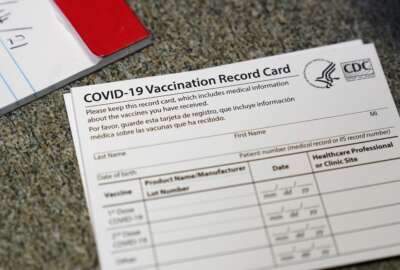Contractors mull the practical realities of the Supreme Court ruling against vaccine mandates
Best listening experience is on Chrome, Firefox or Safari. Subscribe to Federal Drive’s daily audio interviews on Apple Podcasts or PodcastOne. Contractors who...
Best listening experience is on Chrome, Firefox or Safari. Subscribe to Federal Drive’s daily audio interviews on Apple Podcasts or PodcastOne.
Contractors who scrambled to deal with the Biden administration’s vaccine mandate are now scrambling to figure out what to do now that the Supreme Court has struck it down. Especially now that a Texas judge has halted the mandate for federal employees. The Federal Drive with Tom Temin got perspective now from the executive vice president for policy at the Professional Services Council, Stephanie Kostro.
Interview transcript:
Tom Temin: Stephanie, good to have you back.
Stephanie Kostro: Good morning, Tom. Thanks for having me.
Tom Temin: What do contractors think they’re supposed to do now, because this interplay of the one mandate ban, which is supreme, and the Texas level ban on the customer, is unsure yet. And so it must be confusing.
Stephanie Kostro: It is confusing, and we have sort of a Holy Trinity of court decisions that came out. One was, as you said, in early December for specifically federal contractors, and that was a nationwide stay out of Georgia, and a district court down there, saying that it is unenforceable, there’s an injunction. Then the Supreme Court came out on Jan. 13, and said, the OSHA emergency temporary standard is not allowed. And so that was a strike against the Biden-Harris administration’s push. But that Supreme Court decision also did say, if there are specific workplaces and specific conditions, we would reconsider. And you saw that in the other part of their decision, which was to have the mandate in place for healthcare facilities that receive Medicaid or Medicare dollars. And then just last week, we saw that the Texas court judge in the Southern District of Texas say he was not going to rule on the federal contractor mandate, because that was already under the nationwide stay. But now against federal civilians, there is a standard requirement for them to be vaccinated. All of this contributes to this maelstrom of what do federal contractors do?
We have put out our perspective from the Professional Services Council to our PSC members, and we’ve covered six things. One is what is covered under this ruling, that is just the brief soliloquy. The second was none of this really impacted the date, the date to be vaccinated for federal contractors, fully vaccinated, which means two weeks after your final dose of a vaccine was supposed to have been Jan. 18, that is still in some contracts, there’s just no enforcement of it as long as the stay is in place. That brings me to our third point to our member companies. And that is a court decision could reverse that state at any time with no notice. And so, if your workforce is vaccinated, that’s great, don’t necessarily think that this vaccine mandate is going away, another circuit court could could vacate this day or otherwise modify it. And then finally, one of the key points that we raise is facilities access. Government owned facilities can have their own set of requirements in order for someone to enter into or work at that facility. And so we’ve seen, for example, the Pentagon, there is a vaccine or test mandate. So either you have to show that you were fully vaccinated, or you can show a recent negative test, or have an on-site test. There are lots of organizations that are taking similar tactics on facilities access, and the courts have not spoken out about that.
Tom Temin: Right, and companies still have the ability to require vaccines at their discretion for their employees and are members taking different tacks there?
Stephanie Kostro: So in September, when the president announced that he, his administration would be mandating vaccines in certain communities, many companies went out and said, we have our own internal vaccine mandate, because we saw this train coming down the track, and we wanted to get ahead of it. That said, some of these companies have come out and said, well, we’ve vaccinated 90% of our workforce, 80% of our workforce, we’ve offered religious exceptions or medical exemptions to another certain percentage of it. So roughly anywhere between two and 10% of our workforce are now unvaccinated and uncovered, if I could say that, unaccepted for religious or medical reasons. It’s that minority of workforce that we’re really talking about here. And some companies have decided to continue to push and others have decided to wait and see. It’s a it’s a very interesting time to be watching the human resources aspect of this. And coupled with the the legal aspect and what’s going through the court system.
Tom Temin: We’re speaking with Stephanie Kostro, she’s executive vice president for policy at the Professional Services Council. So while that’s all up in the air, another kind of cannon ball is rolling down toward contractors, and that is the EPA’s advanced notice of proposed rulemaking with respect to lowering the climate footprint, or the carbon output, whatever you want to call it, by contractors, and this is going to be an issue, isn’t it, coming up?
Stephanie Kostro: It is I’m just going to use the shorthand, ANPR it’s an advanced notice of proposed rulemaking. This came out late last year and had to be extended, the comment period was extended for an additional month because there were lots of people and organizations offering feedback. My understanding is that they have received 35,000 or so sets of comments and they’re wading through those as fast as I’m sure as they can. This ANPR really asked for information regarding targeting, minimizing and reporting greenhouse gas emissions. It was very focused on greenhouse gas emissions. What was interesting is they didn’t offer definitions, but were rather soliciting input on how do you define the social cost of greenhouse gas emissions. There is an interagency working group tackling some of this and their recommendation is already overdue to the White House. But as we move forward, what I find fascinating is that the FAR Council and the folks in the rulemaking process on the government side are really looking to industry to define what future requirements will be. And this is why so many stakeholders are offering input.
Tom Temin: And in this case, the 35,000 comments are unlikely to be 29,000 of the exact same identical one robo-submitted. But there might be some actual variation among the comments and some real nuance.
Stephanie Kostro: Oh, absolutely. I think you’re going to get both ends of the spectrum, you’re going to get folks who are heavy greenhouse gas emitters, talking about qualitative versus quantitative, what are they doing in this space? You’re going to get folks who are heavily invested in the petroleum area offering comments and then you’ll you get comments from from folks like us, the Professional Services Council, really focused on how can we define this for contractors? How can we have folks looking at bid proposals have an apples to apples comparison, as opposed to, you’re using your electric feet fleet over here, but you’re making in Company A, but you’re making these reductions in your carbon footprint for Company B? How do you have a contracting evaluation team look at this and say, I know exactly which one is the better deal, or the better long term solution for minimizing the risk of climate change. It’s tough. And so we’ve been arguing at the Professional Services Council, that we need better definitions for what the government is looking for. We’ve offered some recommendations or some thoughts on which existing protocols are out there, there’s no need to reinvent the wheel. There’s been a lot of work in this space. And so offering our recommendation to the government that, please, you know, just look before you leave. Make the requirements, something that everyone understands that everyone can take accountability and responsibility for. And use existing tools that are in the toolkit don’t reinvent the wheel.
Tom Temin: Well, anyway, professional services firms are a bunch of people showing up in an office or even if they are showing up in an office, and thinking and writing things and sending it back to the government basically, doing code and sending code over the internet. It’s not like you’re building fuel tanks and putting giant steel welded structures through annealing furnaces, and then painting them and baking them in a furnace and delivering to the government. There’s energy being used. But I don’t understand what the, how you can even calculate the so called carbon footprint of a professional. It’s like, what does a law firm use? Well, the building is heated and we drive to work.
Stephanie Kostro: There is that piece of it, Tom, but you have to remember that oftentimes professional services or a business unit or an arm of a larger agglomeration or a corporation or a company, and in some cases, we’re looking really at the small businesses and what does this mean for them? And if they’re going to face the same kinds of requirements, whether in reductions or just basic uses of carbon. What does it mean for them? And so, I take your point that professional services are often folks who sit at desks or work on computers, or you know, as you put it, code and engineer and do some research, I get that piece, but it is part of a larger, can I use the word ecosystem, of companies that that really this can impact quite heavily.
Tom Temin: Sure. We could say, well, our engineers stopped using electric calculators, we’ve gone back to slide rules because they use no energy. Well, they are made out of plastic, that could be a problem.
Stephanie Kostro: We could use wooden slides, or a slate really.
Tom Temin: Chalk. And while we have you, too, just briefly there is a survey report that you teamed up with Maximus, to talk to some federal CIOs. Any highlights we need to know about?
Stephanie Kostro: Sure. It’s funny. We do this annual CIO Federal CIO survey, and we talked to scores of federal CIOs just to get their lay of the land, we teamed up with Maximus, who is a PSC member company. And you know, it’s funny. When we talk about data transformation, or we talk about IT modernization, a lot of times, it’s a little amorphous. These federal CIOs know exactly what they’re talking about, and they know exactly what they need. So really prioritizing emerging technologies, facing some of the same workforce issues that the private sector is facing in terms of attracting and retaining talent. A lot of times the government in the past has touted we’ve got this great benefits package. Well, a lot of private sector companies have pretty awesome perks and benefits as well. And so, as you move forward, they’re trying to figure out how to incorporate innovation, how to use the existing authorities and tools and do a gap analysis of what tools and authorities they might need to access the innovation and tech that they need.
The key takeaway for me are threefold. One is that the federal workforce, they’ve got to look at it from a person perspective, as opposed to just looking at it as tech experts, broadly speaking. The second is how to incorporate cybersecurity thinking when they’re talking about CIOs. Sometimes that’s between the CIO and the CISO, the chief information security officer, and how to make sure that those folks are talking to each other incorporating cybersecurity thinking. And finally, and perhaps most importantly, how to prioritize critical emergent technologies, things like AI, you mentioned earlier in our conversation, we talked about the 35,000 comments that the government has gotten on this advanced notice of proposed rulemaking for minimizing the risk of climate change. You know, isn’t this a great use of AI to be able to comb through 35,000 sets of comments? But how does the government do that? How do they how do they actually incorporate AI in a responsible way, and use data driven analytics? So, in a nutshell, Tom, we’re rolling out our report with Maximus later today. And we hope that we can answer lots of questions that this IP space has.
Tom Temin: Alright, so basically, though, the finding is you need good meatware if you’re going to have good software.
Stephanie Kostro: That’s one of the takeaways, Tom. Yeah.
Tom Temin: All right. Stephanie Kostro is eecutive vice president of policy at the Professional Services Council. As always, great to have you.
Stephanie Kostro: Thanks, Tom.
Copyright © 2024 Federal News Network. All rights reserved. This website is not intended for users located within the European Economic Area.
Tom Temin is host of the Federal Drive and has been providing insight on federal technology and management issues for more than 30 years.
Follow @tteminWFED
Related Stories






